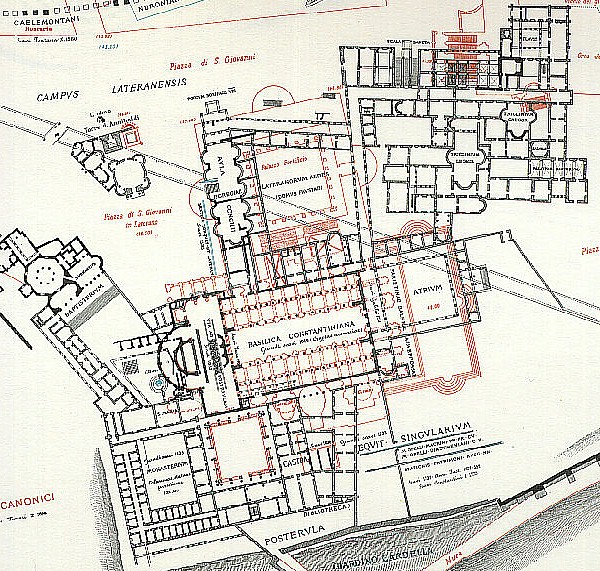1999.04.01 Holy Thursday
a recollection of the day's events.1
My day began with an early morning Internet search of St. Agnes. I specifically wanted to locate a previously found Internet reference that attributed the original (early Christian) building of the St. Agnese basilica in Rome to Constantina, Constantine the Great's daughter. I found the St. Agnes-Constanti(n)a reference, however, during the search process I also accidentally found St. Helena, the mother of Constantine and the grandmother of Constantina. My "discovery" of Helena occurred while reading The Catholic Encyclopedia's online entry on Constantine, where there is a hyperlink to St. Helena. Seeing that Constantine's mother is a proclaimed saint naturally sparked my curiosity. The St. Helena hyperlink connects to The Catholic Encyclopedia's online entry on St. Helena herself, and it was there that I found out that it was not Constantina who was behind all the early Christian church building but rather Helena: Tradition links her name with the building of Christian churches in the cities of the West, where the imperial court resided, notably at Rome and Trier, and there is no reason for rejecting this tradition, for we know positively through Eusebius that Helena erected churches on the hallowed spots of Palestine. Despite her advanced age she undertook a journey to Palestine when Constantine, through his victory over Licinius, had become sole master of the Roman Empire, subsequently, therefore, to the year 324. It was in Palestine, as we learn from Eusebius, that she had resolved to bring to God, the King of kings, the homage and tribute of her devotion. She lavished on that land her bounties and good deeds, she "explored it with remarkable discernment", and "visited it with the care and solicitude of the emperor himself". Then, when she "had shown due veneration to the footsteps of the Saviour", she had two churches erected for the worship of God: one was raised in Bethlehem near the Grotto of the Nativity, the other on the Mount of the Ascension, near Jerusalem. Suddenly, and most unexpectedly, my (re)search turned from St. Agnes and Constantina towards St. Helena. Admittedly, I did not immediately comprehend that Helena was indeed that "builder" of the first Christian churches for which I searched, yet, within an hour of further research, I realized that Helena may well be the first master architect of Christianity.
| |

Rodolfo Lanciani, Forma Urbis Romae (Rome: Edizioni Quasar, 1989).
197-203
|
Dedications in the Castra Equitium Singularium found below the nave of the basilica on an Ionic capital.
|
297-298
|
Fragmentary inscriptions referring to Diocletian and Maximian found in excavations, 1934-8, inside the remains of the Castra Equitium Singularium.
|
end of
312 (?)
|
Constantine founds the Lateran basilica, subsequently called after him the Basilica Constantiniana, has it decorated and endows it with furnishings and landed property.
|
9 Nov. 312
or
9 Nov. 318
|
«Quinto idus nov. Romae dedicatio basilicae Salvatoris», referring either to its founding, in that case November 312 or to its consecration, 318; these being the only years in the reign of Constantine and Sylvester when November 9 falls on Sunday, as customary for church dedications.
|
Richard Krautheimer, Corpus basilicarum Christianarum Romae: Le basiliche cristiane antichi di Roma (sec. IV-IX) (Cittá del Vaticano: Pontificio istituto di archeologia cristiana, 1937-).
"[referring the Basilica Constantiniani] Construction need not have taken many years. The huge Basilica Nova [another building] with its time-consuming vaulting system was built and completely decorated in four or five years; and we shall see that at St. Peter's construction and interior decoration were presumably completed in the course of six to eight years. The Lateran basilica, being smaller than St. Peter's, might well have been built and finished within five or six years. Dates given for the consecration are numerous, varying from 315 to 324, but they are never based on any sources. The Martyrologium Romanum gives November 9 as the feast day of the basilica, "Romae dedicatio Basilicae Salvatoris". However, as pointed out by Lauer, the date occurs first in the second version of the Descriptio Ecclesiae Lateranensis, 1153-1154: "Cuius dedicatio per totum orbum quinto idus novembris...celebratur...". By that time, then, the tradition was well established, but we do not know how far back it went. It is certainly older than the twelfth century, but it does not occur in the early sacramentaries and martyrologia dating from the fifth to ninth century. Is it, then, the date of a reconsecration after the rebuilding by Sergius III (904-911)? This is possible, but it is equally possible that the tradition springs from a fourth century root. We leave the question open. In any event, no year is given. However, it is curious that in the reigns of Constantine and Sylvester, November 9 falls on a Sunday--since the Middle Ages the customary day for church consecrations--only four times: 312, 318, 329, 335. The last two dates can be dispensed with: the period of construction [beginning from] 313 or 314 would be too long. However, 318 would be a very plausible date for the consecration of the church. Or should we stress the choice of the word dedicatio, rather than consecratio, by the sources? Dedicatio in Roman legal language is the act of handing over or ceding--dedere--an object, be it real estate or something else, to a deity; the act of consecratio follows, once the object has been installed or the shrine, temple or whatever, has been built. Is it possible, then, that November 9, 312, not quite two weeks after his conquest of Rome, was the day Constantine ceded to Christ the terrain on which the basilica was to be built and made the endowment for its future maintenance, in servitio luminum?"
Richard Krautheimer, Corpus basilicarum Christianarum Romae: Le basiliche cristiane antichi di Roma (sec. IV-IX) (Cittá del Vaticano: Pontificio istituto di archeologia cristiana, 1937-), p. 90.
|
